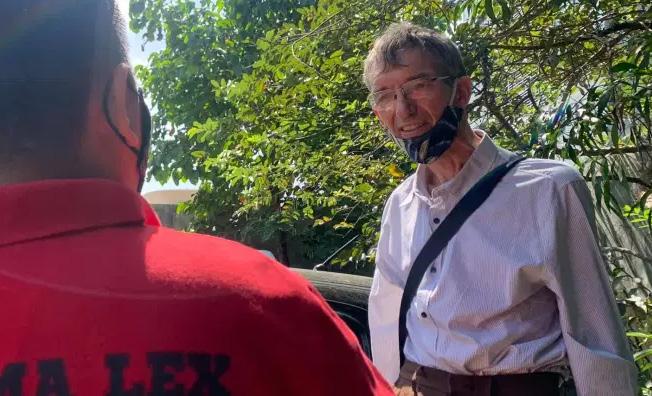
34 minute read
NEWS
Dutch missionary Otto de Vries has been a champion of workers’ rights in the country. His residency visa was recently revoked.
After 30 years of service, state takes aim on missionary
Advertisement
Otto de Vries asserts that his hands are not the devil’s workshop as labor groups hit decision
BY TAJ SAMUEL LAGULAO UPLB Perspective Staff Writer
The state’s red-tagging streak continues with their latest target: Dutch missionary and labor rights activist Otto de Vries, whose visa of permanent residence is being revoked.
The reason? He was participating in protest rallies that the National Intelligence Coordinating Agency (NICA) unjustifiably labeled in a December 2019 letter as organized by “Communist-Terrorist Groups front organizations.”
Such was the driving force behind the Bureau of Immigration’s (BI) decision, with the bureau using Philippine Immigration Act of 1940 as further justification.
In a report by the Inquirer, Bureau Commissioner Jaimie Morente explained that under the act, foreigners are not allowed to participate in any form of political activities such as rallies.
“There are no exemptions. Foreign nationals, regardless of their visa type, may not engage in partisan political activities,” Morente said, with the bureau emphasizing that his case had been pending since 2019. It was only this January 23 when they requested de Vries to submit his counter affidavit.
Doing the Lord’s work
De Vries, who claimed to have been living with the urban poor in the City of Pasig for 20 years and is a member of the Diocese of Rotterdam, debunked the allegations raised by BI and NICA in a testimony published in Bulatlat, saying that the cancellation of his visa was “without any valid and legal cause.”
“Contrary to the accusations of NICA, neither I nor EILER engage in acts of terrorism. Further, EILER publishes research and educational modules based on facts and concrete conditions of the workers. It does not publish propaganda or any materials that support terrorist organizations,” de Vries retorted.
He was involved with the “well-established research NGO [non-government organization]” Ecumenical Institute for Labor Education and Research (EILER) after he shared a copy of a study he made.
The paper in question discussed the
He is more Filipino than the police and military that harass the masses... He is more Filipino than Duterte who willingly surrenders our freedom and sovereignty to foreign powers.
KILUSANG MAYO UNO
Statement
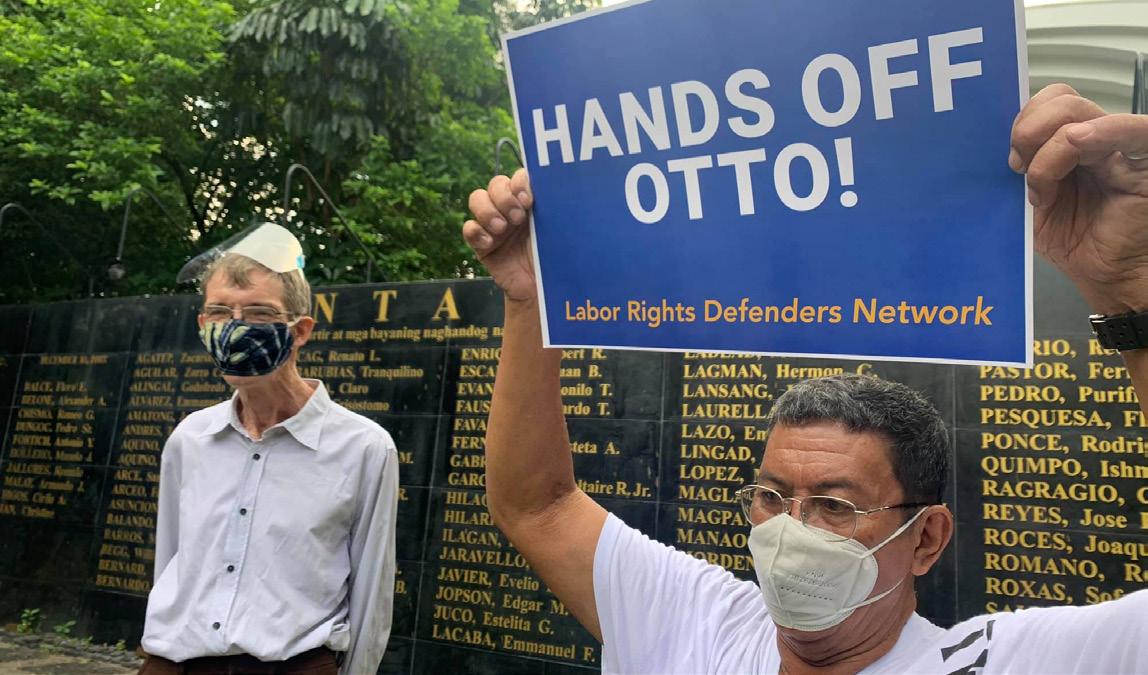
Last Ash Wednesday, de Vries faced the media after the government ordered him to leave the country. Labor groups are aghast at another attack by the state.
PHOTO FROM DEFEND JOBS PHILIPPINES possible worsening working conditions of laborers in subcontracted jobs.
“I wrote about the subcontracting system in one of the last projects I had worked for. In this research I presented how the working conditions worsened on each layer of subcontracted jobs, for the readers to get a better grasp on the construction workers’ situation,” de Vries, citing that his experiences with the working class pushed him to write.
Around 2015, following an accident, he joined EILER as a research volunteer after believing that both church work and labor were “indispensible.” Despite the accusations, de Vries stood firm and asserted that he will continue his “mission” in the country.
“For almost 30 years, I was granted the privilege of being issued a permanent resident VISA [sic]. I have been living my mission in the Philippines and I have no further desire than to continue my mission among the oppressed workers,” the missionary concluded.
He who is without sin
Progressive groups took to social media to help de Vries in carrying his cross, uniting with the #HandsOffOtto. National labor center Kilusang Mayo Uno (KMU) denounced the blacklisting and order to leave, claiming that the allegations are “unfounded and malicious.”
“Otto is a friend of workers and the poor. He is in no way a terrorist... For years, he has immersed himself in workplaces and communities to study the conditions of the Filipino workers,” said KMU.
Additionally, KMU noted that even before President Duterte took office, de Vries had already been helping workers through forums and educational sessions, and by volunteering for the EILER.
“He is more of a Filipino than corrupt government officials that steal from the nation’s coffers. He is more Filipino than the police and military that harass, arrest and kill workers, peasants and indigenous peoples. He is more Filipino than Duterte who willingly surrenders our freedom and sovereignty to foreign powers,” the labor center exclaimed.
Meanwhile, labor group Defend Jobs Philippines likened the situation to that of Sister Patricia Fox, an Australian nun and human rights defender who was deported for criticizing Duterte back in 2018.
“Instead of deporting, harassing and prosecuting foreign nationals like Fox and De Vries, the current administration must have thanked and appreciated their efforts in volunteering to uphold, promote and defend our working people’s fundamental rights for secured jobs, higher wages, safe workplaces, labor rights protection among others – which should have been the role of the State in the first place,” said the organization.
The Student Christian Movement of the Philippines (SCMP) also defended de Vries, pointing out that NCIA’s red-tagging acts were because they are a part of Duterte’s National Task Force to End Local Communist Armed Conflict (NTF-ELCAC).
“Otto de Vries is not a terrorist. The government’s allegations against Otto are based on the long-refuted accusation that Church work that serves the marginalized in our country is a front for terrorism. This is an affront to our apostolic mission to serve the poor masses, especially in these perilous times for the people,” said SCMP.
SCMP added that in time Duterte and his state forces will all regret their persecutions against the faithful, and called on the Christian youth to defend Church workers facing state terrorism.
7 Lumad children illegally flown to Davao after raid
Terror in Cebu continues after Feb. 15 operation
BY CHARLES ALISON RIVERA UPLB Perspective Staff Writer
Days after a bakwit school in Cebu faced the wrath of the state, seven Lumad children were reportedly flown to Davao without the consent of their parents.
This being the latest attack on Lumads under the Duterte administration, with military forces bombing their homes that were presumed to be communist breeding grounds, or driven out of their ancestral lands by private corporations exploiting the environment.
“Lumads have been forced off of their homes to make way for mining companies and plantations. Their schools have been bombed, burnt, and shot into. Because of this, schools have been set up in churches and universities across the Philippines to offer students sanctuary and a place to continue their education. Yet the attacks continue,” Save Our Schools (SOS) Network said.
Elements of Armed Forces of the Philippines (AFP), Philippine National Police Police Regional Office-7 (PNP PRO-7), and the Department of Social Welfare and Development (DSWD), with the aid of paramilitary elements of Alamara, launched a “rescue operation” last February 15.
Their supposed goal being to rescue Lumad children from being trained as child rebel soldiers in University of San Carlos (USC) Talamban Campus in Cebu City. From this, 26 unarmed Lumad students and elders, and even teachers were left terrified rather than safe.
“The police and DSWD claimed they were “rescuing” the Lumad children, as they brought parents all the way from Talaingod to Cebu. But from whom are they being rescued from?” SOS Network said in their latest update today, explaining that even now, they still have no word where the 25 Bakwit School constituents are.
Then, last February 21, of the 13 Lumad children, six were to remain with DSWD in Cebu without their parents, while the other seven were to be transported to Talaingod, Davao del Norte. All of this without any consent from their parents or paperwork, SOS Network Cebu asserted.
“Being vanguards of the child rights and welfare, we are taking this concern with utmost prudence and making it a top priority until the children will be turned over to proper individuals,” the network affirmed.
Although the Children’s Legal Bureau (CLB) were tapped by the parents of the seven to intervene and aid SOS Network Cebu, the flight still proceeded as scheduled.
“We assert once again that without a court order, written parents’ consent, or the presence of their parents, the DSWS, DSWD, WCPD-PNP, and Talaingod LGU and LSWDO have no legal authority to transfer the children!”
Second time around
Among the 26 detained was UP Diliman graduate and human rights activist volunteer Chad Booc. More recognized as a volunteer for Alternative Learning Center for Agricultural and Livelihood Development (ALCADEV) Lumad school, Booc endured several times being branded as a communist or a terrorist on social media prior to his arrest. He was one of the petitioners working against the Terror Law.
This was not his first being detained, however, as Booc was put behind bars in 2017 after he and seven other individuals protested against the extension of Martial Law in Mindanao during a congressional session on the Marawi siege. They were charged with “disturbance of proceedings” under Article 144 of the Revised Penal Code.
National Union of People’s Lawyers (NUPL), who will stand as the legal counsel of the Lumad 26, said that numerous charges will be filed against the arrested individuals, including “kidnapping and serious illegal detention” under Republic Act (RA) 7610 (Protection on Children Abuse, Exploitation, and Discrimination Act) and RA 9208 (Anti-Human Trafficking Act of 2003).
Recently, Booc, alongside Roshelle Porcadilla, Benito Bay-ao, Segundo Milong, Jomar Benag, Esmelito Oribawan (six others also detained from the raid) were being charged with “illegal detention and kidnapping.” This was according to SOS Network Cebu’s update last February 17.
S.O.S.
The so-called “rescue operation” came to the surprise of Societas Verbi Divini (SVD) Philippines Southern Province Chapter who were the ones to give shelter and necessities to the Bakwits situated within Cebu City during this COVID-19 pandemic.
In a joint statement, they and the USC administration “clarified surrounding facts” in relation to the raid yesterday. SVD hosted 42 Bakwit in their retreat houses that are accessible near the USC Talamban Campus on March 11 back in 2020. They were supposed to complete their modular learning by April 3.
On March 13, 2020, the Cebu City local government unit (LGU) placed restrictions in an effort to stop the spread of COVID-19, thus barring the Lumad community from returning to their indigenous homes. Since then, the SVD sheltered the Lumad community and provided their necessities and facilities.
The SVD and USC condemned the said raid that involved the presence of the state forces.
“While the Archdiocese of Cebu-Commission on Social Advocacies mentioned that some parents were coming over to fetch their children, it did not dawn on us that the parents’ visit will necessitate the presence of policemen,” the statement reads.
The joint statement also proved that the Lumad community living within their vicinity is well-treated and cared for, hence, the term ‘rescue’ is not appropriate.
“Here, no rescue need ever be conducted because the presence of the Lumads in the retreat house was for their welfare and well-being, and all throughout [their stay], they were nurtured, cared for, and treated with their best interest in mind,” they said.
Meanwhile, SOS Network condemned the continued involvement of the United States of America’s government in local affairs.
“Obama, Trump, and now Biden have shifted the “War on Terror” to the shores of the Philippines, which has in turn intensified the accusations of terrorism on indigenous, activist, religious, and educational entities like Lumad schools.”
“The real acts of terror have been committed by the Philippine government and sponsored by the US,” the group explained, asking for willing individuals to donate to Lumad advocacy groups and to remain updated on developments.

A lawyer from the National Union of People’s Lawyers talks to detained human rights activist Chad Booc, one of 26 arrested in Cebu City last week. PHOTO FROM SOS NETWORK CEBU
Universal condemnation
We assert once again that the PNP has no legal authority to transfer the children!
SAVE OUR SCHOOLS NETWORK
Statement
Here, no rescue need ever be conducted because the presence of the Lumads... was for their welfare
PNP’s lies over agreement bared
Chancellor Camacho debunks PNP’s report of partnership; campus remains off-limits from police and military
BY JOAQUIN GONZALEZ UPLB Perspective Staff Writer
Last January 29, Philippine National Police (PNP) posted about a partnership with the UPLB administration. This was after Chancellor Jose Camacho, Jr. and other UPLB officials visited the Laguna Police Provincial Office (LPPO). Key points from the post included the crafting of memorandums for a February 2021 program known as “UPLB Ko, Bantay Ko” and an “Off-Campus Graduate Program on Strategic Planning and Development Management” for certain LPPO personnel.
PNP then claimed that they are ready to help curtail criminal, drug, or insurgency-related activities. However, Camacho himself immediately said that no such deal took place. He emphasized that the visit was to assert the UP-DND Accord following Department of National Defense’s (DND) abrogation. He later said that the campus remained prohibited from police in a separate statement.
The Accord is an agreement between the university and DND that would restrict campus grounds to any state agents, from police officers to soldiers, to assure that academic freedom was upheld.
Fact-checking PNP’s claims
A day prior to the post, the UPLB website posted an in-depth report regarding the meeting. In it, the UPLB administration, together with the Laguna Police Provincial Office (LPPO), as well as Gov. Ramil Hernandez and Rep. Ruth Mariano-Hernandez discussed attempts at “strong community relations at the provincial level.”
It is noticeable, however, that the report did not reference the PNP at all, with the UPF and the LPPO being the only “police” mentioned. The report said that UPLB Ko, Bantay Ko is a 2012 information and security training program done with LB police and its local government unit (LGU). It said that this was among the possible activities being discussed to fulfill the agenda.
Seminars for drug awareness, and training sessions for investigations and arrests were mentioned, much like in PNP’s post, but are revealed to be more for the UPF and not for the UPLB community. Such events would be spearheaded by the LPPO instead. While PNP said that it was agreed to have quarterly or emergency meetings with LPPO, LB Police, and barangay chairpersons working around campus, there was no mention of this in the report.
The idea of a “Off-Campus Graduate Program on Strategic Planning and Development Management” also had a different context in the report, in that the administration was merely inviting LPPO staff to try the program. There was also nothing to suggest that a proposal for a memorandum of agreement (MOA) was in the cards.
Finally, Camacho explained that this support of the local police’s “mobile capability” pertained to a gas assistance program that began in the term of then-Chancellor Rex Victor Cruz, with the report mentioning a “gasoline ration” for LB police and Sangguniang Barangays. Camacho said that this was for swift emergency responses, after the murders of Given Grace Cebanico and Ray Bernard Peñaranda . Peñaranda, an agriculture student, was held-up then stabbed to death near UPLB in 2012, while Given Grace Cebanico was a UPLB computer science student who was raped and killed also near campus grounds in October 2011.
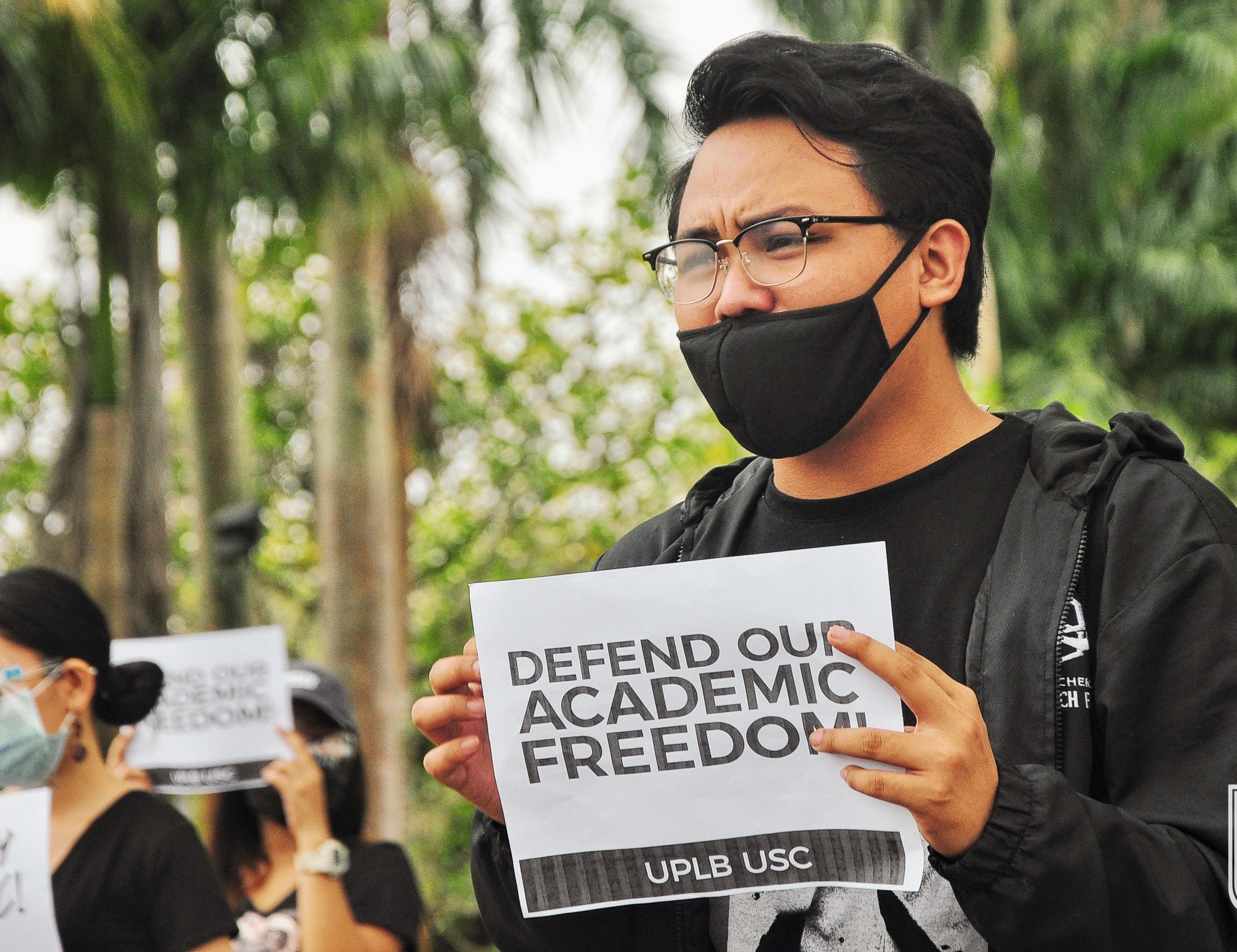
USC Chairperson Jainno Bongon during a rally against the abrogation of the UPDND Accord. The USC has criticized the PNP over its meeting with UPLB officials.
[P] PHOTO BY DIANNE SANCHEZ
How can we trust the PNP if they would continue occurrences of misinformation, redtagging, and harassment?
UNIVERSITY FRESHMEN COUNCIL
Statement ONLINE
uplbperspective.org
For more details, read the complete story on our website http://bit.ly/PNPUPLB
As pandemic continues siege, Feb Fair goes virtual for the first time
BY RUBEN BELMONTE UPLB Perspective Staff Writer
Instead of a weeklong festivity of cheers, stage lights, and shawarma, the annual Feb Fair will be a single livestream due to the pandemic.
The performances, political advocacies, and other related events and segments won’t be happening in the Freedom Park’s stage this year. Instead, for one day only, this year’s UPLB February Fair will be streamed through Facebook Live on the event’s page, this February 28, from 3 p.m. to 7 p.m.
“Due to the unfortunate circumstances brought about by the COVID-19 pandemic, this year’s Feb Fair will have a different approach. We will be implementing and celebrating the said event in an online setting and all performances, as well as political advocacies, will happen on a single day,” UPLB All Student Councils’ Assembly (ASCA) said in a promotional letter.
The theme will be “Balik-Tanaw,” with the event aiming to reflect on the event’s roots through the “striking similarities to the socio political [sic] climate of today” and the events that lead to the creation of Feb Fair.
UPLB ASCA, who has been hosting the said event since September 1972, decided to push through such an event to continue half a century-long tradition. The beneficiaries for this year’s Feb Fair will be the UPLB students who will need assistance for the incoming semester of AY 2020-2021.
Additionally, some annual activities such as the singing competition Star in Carillion, hosted by UPLB Development Communicators’ Society, Inc. (DCS), will be held online on February 27.
Titled “SIC 18 Natatangi Ka: A Benefit Concert,” his event will function more as a benefit concert, in cooperation with Christian Foundation for Persons with Disabilities, Inc.
Beginning as a protest fair when the Marcos regime declared Martial Law in the 70s, becoming what is said to be the first mass gathering in the country, Feb Fair was originally held in September as a way of expressing dissent against the 14-years of dictatorship and the worsening state of the country up until today.
The UPLB ASCA’s hosting of the event was due “in line with the student councils’ mandate to develop social awareness and responsibility geared towards the development of a nationalistic spirit rooted in democratic principles.”
The annual celebration caters mostly to the Southern Tagalog audience and consists of not just a lineup of performances and band guests, but also local exhibitions and stagings of different student organizations as well as advocacy campaigns in between.
Oppression in Hacienda Yulo persists
More Hacienda Yulo homes ransacked, residents harassed by ‘hired goons’ as farmers hold ground against onslaught
BY RUBEN BELMONTE UPLB Perspective Staff Writer
‘Hired goons’ continue their Hacienda Yulo alleged demolition derby, with more homes destroyed and more farmers harassed.
Hacienda Yulo sees a second wave of attacks from ‘hired goons’ of the Yulo clan and the Ayala Corporation. This was only the latest development in a decades-long battle against institutionalized land grabbing and land use conversion, and the most recent among a barrage that began in early January. Yulo farmers and residents themselves have been calling for land reform in Hacienda Yulo and against institutionalized land grabbing and land use conversion since the 90s.
For farmer and resident Shirley Marasigan, she had to witness two goons drawing their guns on her two daughters’ heads and forcing them to lie on the ground. One of the men had a gasoline container and the other took their cell phone. “Walang awa nilang binuhusan ang loob ng aking pamamahay ng dalawang galong gasolina. Nakiusap ako sa kanila na baka pwede po kaming maglabas ng gamit... hindi sila pumayag sabay duro samin at sumigaw ang isang lalaki ng ‘labas, dapa!’” Marasigan recalled.
Resident and Samahan ng mga Magsasakang Nagkakaisa sa Buntog (SAMANA-Buntog) member Jojo De Leon recalled his experience in a press conference held with Defend Yulo Farmers. “Noong Janaury 26 sa bahay namin, nagpunta ang mga goons — trenta [30] katao — kasama ang Seraph Agency. Nakita ko ang mga kapatid ko, pinsan, at mga taga-roon, ay anim po ang binugbog nila,” De Leon said.
De Leon was among the many residents who had to witness his home be burned to a crisp last January 19. “Noong February 2, nagtangka po ang mga taong simbahan na magdala ng relief. Gutom na po ang mga mamamayan sa Sitio Buntog. Hanggang ngayon ay hirap na hirap magdala ng pagakain doon dahil hinaharang nila,” De Leon said.
This referred to a relief goods team composed of 18 church workers who were on their way to the Hacienda Yulo community of Sitio Buntog, Brgy. Canlubang in Calamba. Tanggol Magsasaka Timog Katagalugan explained that the 18 only sought to provide food and assistance to the farmers and residents, but a food blockade barred them from going any further.
De Leon, revealed by Defend Yulo Farmers to be the farmer who had his hand crushed by a gate’s closing in the dialogue with the Calamba municipality last Mendiola Massacre commemoration, concluded that it was difficult for all of them to accept what they have been struggling against, emphasizing how the ordeals have left the farmers traumatized. The remains of Leo Mangubat’s house in Hacienda Yulo, after it was reportedly trashed
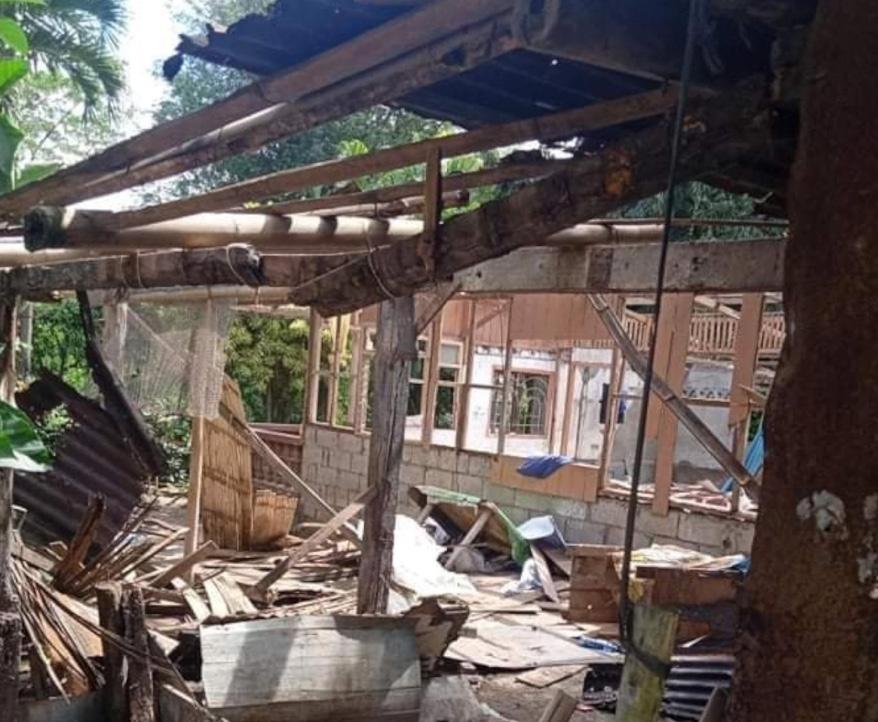
by armed men. PHOTO FROM DEFEND YULO FARMERS FACEBOOK
MAS PINAAGA NA ANG PINAKAMAINIT NA BALITAAN SA SOUTHERN TAGALOG!


TUWING SABADO 10:00 AM
Manggagawa ng Nissan, umaaray sa pagsasara ng pabrika sa Sta. Rosa
NI CARLA DELA CRUZ UPLB Perspective Staff Writer
Isa pang pagawaan ng sasakyan ay nagsara sa Sta. Rosa, Laguna, at sa ngayo’y wala paring konretong plano mula sa pamamahala ng Nissan. Ngayong darating na buwan ng Marso, 133 na manggagawa ng Nissan Philippines Inc. ang inaasahang mawawalan ng trabaho dahil sa pagsasara ng lokal na planta ng Nissan sa Sta. Rosa, Laguna.
Ayon sa liham ng pangulo ng Nissan Philippines Inc. na si Atsushi Najima, napagdesiyunan nilang ituloy ang pagsasara matapos ang pag-expire ng kontrata nito kasama ang kasosyo nitong Filipino vehicle assembly na Univation Motor Philippines Inc. (UMPI).
Ayon sa labor center na Pagkakaisa ng Manggagawa sa Timog Katagalugan-Kilusang Mayo Uno (PAMANTIK-KMU), ang malawakang tanggalan sa mga manggagawa ay dahil “tali ang ekonomiya ng bansa sa dayuhang pamumuhunan, kapital at industriya.”
Dagdag ng PAMANTIK-KMU, lalawig pa ang kawalan ng trabaho sa bansa gawa ng pinaplanong full foreign ownership ng mga kumpanya sa bansa sa ilalim ng administrasyong Duterte.
Tinatayang 4.5 milyong Pilipino ano ang nawalan ng trabaho sa taong 2020. Naabot din sa taon gito ang pinakamataas na unemployment rate ng bansa sa loob ng 15 taon, na umaabot sa 10.4 porsyento. Sa kabila ng pagbaba ng unemployment rate, tumatayaang 3.8 milyong Pilipino pa rin ang walang trabaho. Inapela din ng PAMANTIK-KMU ang pagbibigay ng sapat na ayuda para sa mga manggagagawa ng Nissan.
Isang beses lamang nakatanggap ng ayuda na nagkakahalagang P5,000 ang mga nasabing manggagawa. Ang Kagawaran ng Paggawa at Empleo (DOLE) ay nagbibigay ng one-time cash assistance para sa mga manggagawang natanggal ng trabaho sa ilalim ng kanilang COVID-19 Adjustment Measures Program (CAMP).
Tiniyak naman ng pamunuan ng Nissan Philippines Inc. sa Kagawaran ng Kalakalan at Industriya (DTI) na mabibigyan ng makatwirang kompensasyon ang lahat ng manggagawang apektado ng pagsasara ng planta at tutulungan din silang makahanap ng trabaho sa parehong sektor.
Sa kasalukuyan, ay wala pang inilalabas na pormal na pahayag ang kumpanya tungkol sa kanilang pagsasara at sa mga benepisyong nasasaklaw ng “reasonable compensation package” para sa mga mangagawa.
Pangatlo ang lokal na planta ng Nissan sa Sta. Rosa, Laguna sa mga pagawaan ng sasakyan na nagsara sa lalawigan sa loob ng tatlong taon, kasunod ng Isuzu noong 2019 at Honda noong 2020. Sa Honda kamakailan nagtagumpay ang mga nasisanteng mangagawa at nag-uwi ng 280% separation pay.
ONLINE
26,000 indibidwal sa Quezon, nanganganib sa patuloy na pambobomba ng mga militar
Mahigit isang libong puwersa ng estado ang nakakalat sa ilalim ng pinaigting na operasyon laban sa CPP-NPA-NDF
NI CARLA DELA CRUZ UPLB Perspective Staff Writer
Tinatayang 26,000 indibidwal at 15,000 pamilya sa lalawigan ng Quezon ang kasalukuyang nasa peligro buhat ng patuloy na militarisasyon ng Armed Forces of the Philippines (AFP). Ito ay pagkatapos ng engkwentro sa pagitan ng puwersa ng estado at New People’s Army (NPA) noong ika-5 ng Pebrero kung saan nasawi ang umano’y mataas na kumander ng NPA sa Quezon na si Ronnel Batarlo.
Ayon sa pahayag ng alyansang Tanggol Quezon, nasa higit isang libong pinagsamang pwersa ng 59th at 85th Infantry Batallion ng Philippine Army ang patuloy na nagsasagawa ng mga aerial bombing at pag-strafing kung saan higit 26,000 na katao ang apektado sa 19 na mga barangay sa lalawigan ng Quezon partikular sa mga bayan ng Lopez, Catanauan, Buenavista, Mulanay, at San Narciso.
Naninindigan din sila sa International Humanitarian Law na nararapat na protektahan laban sa iba’t ibang uri ng karahasan ang lahat ng indibidwal at siguraduhing makatao at pantay-pantay ang pagtrato sa bawat isa sa lahat ng pagkakataon.
“Civilians under the power of enemy forces must be treated humanely in all circumstances, without any adverse distinction. They must be protected against all forms of violence and degrading treatment including murder and torture.”
Nabubuhay sa takot
Kasunod ng pagpaslang kay Ronnel Batarlo na kinilala bilang kasapi ng NPA, mahigit sa 14 sundalo ang nanatili sa kanyang bahay sa Macalelon, Quezon kung saan nakaburol ang kanyang mga labi.
Labis na takot ang dala ng mga sundalo sa mga kamag-anak at indibidwal na nais lamang makiramay sa pagkamatay ni Batarlo. Dulot ng pagpapatuloy ng operasyong militar sa iba’t ibang bahagi ng lalawigan ng Quezon ay lubhang napinsala umano ang kabuhayan ng maraming magbubukid at sibilyan.
“Lubos po kaming nababahala sa kalagayan ng mga komunidad at kabuhayan ng mga magsasaka na naapektuhan ng mga pambobomba at operasyong militar ng AFP, lalo na sa ganitong panahon na sinusubukan pa lamang nilang bumangon mula sa epekto ng pandemya at ng mahigpit na lockdown,” pahayag ni Jonabelle Almeyda, tagapagsalita ng Tanggol Quezon.
Bukod sa pinsalang dala ng mga pag-atake ng militar sa mga lupain ay isa pang panganib sa kabuhayan ng mga magsasaka ang patuloy na mga proyektong pang-imprastraktura na nakapapinsala sa kapaligiran.
Sa katimugang Quezon, nananatiling talamak ang mga proyekto tulad ng commercial logging at quarrying. Matatandaan din na sa Quezon din nagaganap ang paggawa ng kontrobersyal na Kaliwa Dam.
Pinatindi umano ng pandemya ang paghihirap ng mga magsasaka sa lalawigan dahil sa mga quarantine protocol kung kaya’t hindi nila lubos na maipagpatuloy ang kanilang
Lubos po kaming nababahala sa kalagayan ng mga komunidad na naapektuhan ng mga pambobomba ng AFP, lalo na sa ganitong panahon ng lockdown.
JONABELLE ALMEYDA Tagapagsalita, Tanggol Quezon
mga kabuhayan dagdag pa ang panggugulo ng militar sa kanilang lalawigan na nagdala ng takot sa mga sibilyan at nakaabala sa kanilang paghahanap-buhay.
Patuloy na paglabag
Matatandaang ang mga operasyon ng militar sa lalawigan ay nag-udyok sa ilang mga pamilya na lumikas mula sa kanilang mga komunidad, o kaya naman ang iba ay pinaghihinalaan at binabansagan bilang mga tagasuporta ng NPA. Matatandaan ang pagsampa ng gawa-gawang kaso ng attempted homicide sa kalihim-heneral ng Karapatan Quezon na si Genelyn Dichoso na nakararanas na umano ng red-tagging bago pa man naupo sa puwesto si Pangulong Rodrigo Duterte.
Bukod dito ay ang ginawang panggigipit sa pamilya ng dating miyembro ng NPA na napaslang sa Catanauan na si Eduardo “Ka Resty” Torrenueva kung saan sila ay isinailalim sa interogasyon ng mga militar sa isang covered court ngunit walang naging konkretong detalye ukol sa pagbabalik ng mga labi.
Noong Nobyembre ay iniulat ang pamamaril ng dalawang hindi pa nakikilalang salarin sa lider ng lokal na sangay ng Coco Levy Fund Ibalik sa Amin (CLAIM) na si Armando Buisan. Noon namang Disyembre, dalawa pang magsasaka na sina Ruben Istokado at Renante de Leon ang iligal na inaresto dahil sa paghihinalang sila umano ay lider ng mga rebeldeng komunista, kung saan iginigiit ng binansagang Atimonan 2 na walang katotohanan ang nasabing paratang.
Nanawagan ang Tanggol Quezon bilang isang alyansa na naglalayong itaguyod ang karapatan ng mga tao sa Quezon na wakasan ang patuloy na mapanirang operasyon ng militar sa lalawigan. Ang Tanggol Quezon ay nagtatag ng 1-araw na sesyon ng psycho-social debriefing, at ecumenical worship sa Catanauan para sa mga pamilyang nakakaranas ng pagkabalisa sanhi ng nagpapatuloy na operasyon ng militar sa kanilang mga komunidad .
“We are very much concerned on the well-being of distressed families affected by such grave events, especially in these trying times that we are just recovering from the crisis brought by the pandemic,” saad ni Almeyda. On their way to support Karapatan Quezon sec-gen Genelyn Dichoso, the alliance reported that authorities harassed them. PHOTO FROM KARAPATAN QUEZON

HR group call to drop Karapatan Quezon sec-gen’s trumped-up homicide case
Last January 28 saw calls for the immediate dismissal of Genelyn Dichoso as the Karapatan Quezon secretary general went on pre-trial for alleged attempted homicide.
“Mula sa mga iligal na pagkaka-aresto at pagkakakulong hanggang sa mga tala ng ekstrahudisyal na pamamaslang, matagumpay niya itong hinarap nang buong tapang at lakas,” Karapatan Timog Katagalugan (TK) said in a Facebook statement, recalling how Dichoso involved herself in various quick response and humanitarian efforts in Quezon.
Also going by “Tita Jen,” Dichoso, said to have been red-tagged even before Pres. Rodrigo Duterte took office, was among the eight (originally said to be nine) members of one of Karapatan’s Quick Response Team (QRT) who were held by police in Brgy. Abuyon, San Narcisco, Quezon last September 18, 2020.
Originally heading to the area to inspect possible human rights violations that took place in an alleged encounter between elements of the 85th Infantry Battalion, Philippine Army (IBPA) and the New People’s Army (NPA). They were then shocked to discover the following day, after being forced to stay in a barangay hall there overnight, that they were being charged. This was despite not breaking any quarantine protocol.
Karapatan-TK explained that, with 13 out of 363 slayings having involved human rights workers and the constant life-threatening presence of red-tagging, it was high time to drop the “trumpedup” charges” against Dichoso.
“Sa ganitong mga numero, lumang tugtugin na ang pagsampa ng gawa-gawang kaso sa mga tulad ni Dichoso. Walang pakundangan siyang dinawit ng mga sundalo bilang kalahok sa isang armadong engkwentro na naging daan upang masampahan siya ng kasong Attempted Homicide,” the alliance said.
Karpatan-TK explained further that Dichoso, temporarily freed to work with the alliance, distributed relief goods for those affected by the typhoons and the COVID-19 pandemic.
“Sa katunayan, abala siya kasama ang grupong Karapatan sa pamimigay ng kaunting tulong sa pamamagitan ng relief goods sa mga kababayan nating lubhang apektado ng bagyo at pandemya habang abala naman ang mga berdugong pwersang militar sa mga batbat nitong paglabag sa karapatang pantao,” Karapatan-TK said.
Three months after Typhoon Ulysses devastated Metro Manila and several areas in Luzon, some shoreline communities along Laguna de Bay are still submerged in flood. In a November 24 Inquirer report, the Regional Disaster Risk Reduction and Management Council in the CALABARZON region identified several lakeshore barangays in Laguna cities including Calamba, San Pedro, Biñan, and the municipalities of Santa Cruz and Pila to be among those still in “under-knee to waist-deep floodwater.”
The water is receding in many areas, but not totally. When Ulysses hit on November 11, Brgy. Dela Paz, Biñan, Laguna resident James Marzon took refuge on the second floor of his family’s home. With at least four steps of their staircase submerged in flood, he says it was a frightening experience because they felt like they had no control.
“Yung pagtaas, ambilis talaga niya […] so nag-start siya ng madaling araw, alas-kwatro […] talampakan pa lang yun and pagggising po hanggang alas-otso […] sa loob palang ng bahay namin yun, dibdib na siya,” he recounts.
For the residents of Brgy. Dela Paz, where streets remain in under-knee water, something of the sort has become so “normal” that almost every household has its own wooden or improvised boat as the main mode of transportation.
“Taon-taon, as in [k]onting malakas na ulan lang sa gabi […] ‘tas tuloy-tuloy hanggang umaga. Expected na po talaga na [babaha],” says Marzon. Marzon is fortunate that his family’s home is located in the central part of the barangay where elevation is a bit higher. But for the families in areas they call “laylayan” — which literally means ‘edge’ — the situation is much worse because of their proximity to the lake.
Meanwhile, the scene of flooded streets in Dela Paz is not exactly new to the residents; but in the aftermath of Ulysses, it felt different. This time around, floodwater is murkier than ever. Streets are overwhelmed with floating garbage producing a foul odor. They say this has not always been the case.
“Ngayon kasi, may burak — kulay kanal ganun, kulay black. Tapos yung mga basura, sobrang dami na talaga. Yung mga tao din kasi, irresponsible din kasi sa basura, kaya rin siguro ganun yung nangyayari ngayon. Dahil dun sa mga basurang natatapon din ng mga tao dito,” Marzon describes.
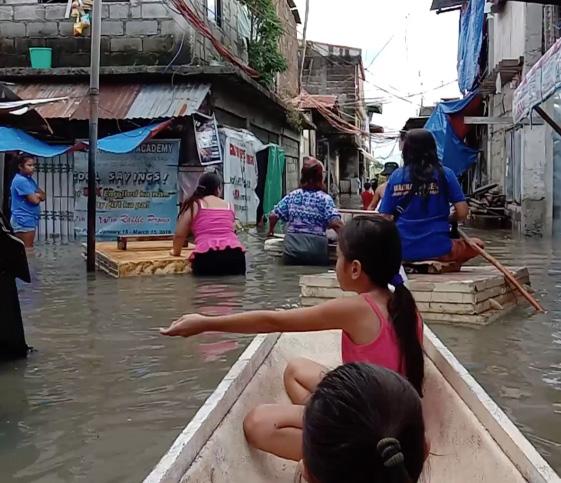
Decades of neglect
Dr. Decibel V. Faustino-Eslava, a geologist and dean of the School of Environmental Science and Management (SESAM) at the University of the Philippines Los Baños (UPLB), explains that there are several contributing factors as to why Laguna de Bay is overflowing to the communities even during light rainfall. “Ang malaking problema natin sa Laguna de [Bay], is the amount of sediments going into the lake. And that has been caused yung several decades of uncontrolled or unregulated upland development na nagde-deliver ng too much sediments and of course, garbage into the rivers and the lakes of Laguna de [Bay],” the SESAM dean says in an exclusive interview with the Perspective.
Faustino-Eslava, who is a part of a group of UP scientists conducting a study on the ecological status of the lake, compares it with a cauldron, saying “when it rains, tumatanggap ng tubig yung watersheds and they all go to the streams and to the river and into the lake.
“And the lake itself is also an open area that receives water from the skies. So dalawang pathways ng rainwater diba from the watersheds and directly into the lake.”
She also notes, the lake has been experiencing “heavier sedimentation or siltation,” which made it much more shallow through the years — failing to accommodate more water.
Sedimentation happens when eroded soil, sand, clay, silt, and other solid materials settle at the bedrock of a body of water. Faustino-Eslava identifies waterways such as Pasig-Marikina river systems and the Pagsanjan river as among the highest suppliers of sediments to the lake.
“And that’s the reason why, for example, yung Dela Paz na barangay is now flooded, and is still probably flooded kasi […] mas mababaw yung lake, mas matagal pati siyang mag-flow out of the lake.”
“And it’s not just Dela Paz. All around the lake, ganyan yung sitwasyon ng coastal communities,” she explains further.
The geologist’s group is recommending regular but “pinpointed” dredging in the lake to maintain or even improve its water levels.
However, because of the size of Laguna de Bay, the negative environmental impacts it would bring as it would “disturb the sediments,” and how expensive it is to push through, she says it would be “not practical” to desilt the entire lake.
“Una, magastos mag-dredge, pangalawa, marami siyang negative environmental
Still no end in sight for Laguna residents who have experienced floods due to typhoon “Ulysses”.
CONTRIBUTED BY JAMES MARZON
A longtime tragedy in the making
Months after Typhoon Ulysses wrecked havoc in Southern Tagalog, some communities are still flooded by water from the Laguna de Bay. We talked to a UP scientist to understand why tha lake keeps on flooding its shore communities. Special report by Dean Carlo Valmeo
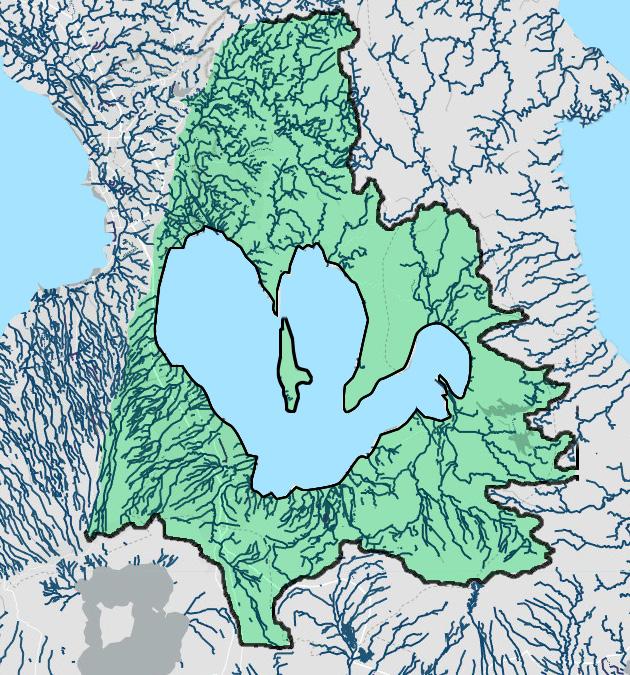
DR. DECIBEL V. FAUSTINO-ESLAVA
Geologist, UPLB SESAM
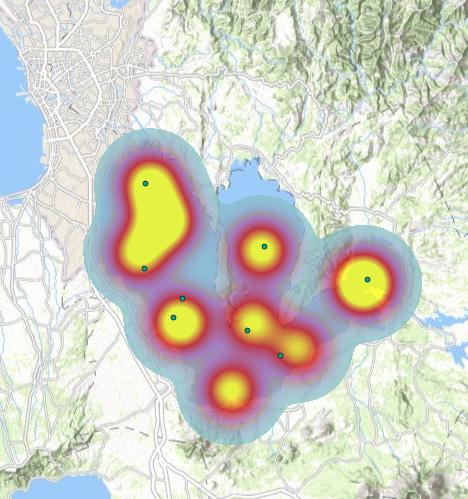
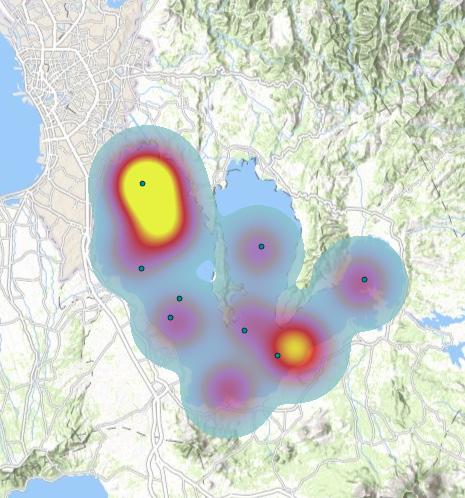
impacts, especially because you disturb the sediments. So those suggestions that we have in the book are meant to minimize the negative impacts and then maximize the benefits from dredging,” she adds.
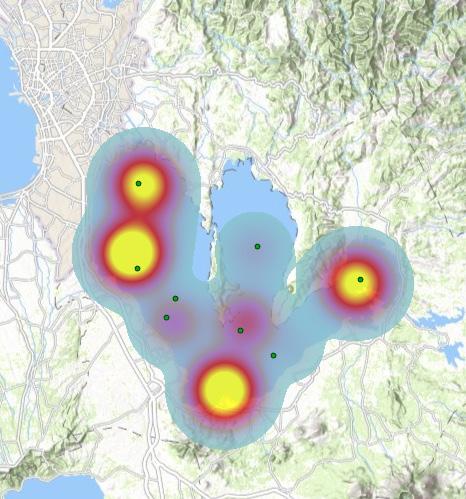
Polluted and contaminated water
Another concern for Laguna de Bay is the presence of fecal coliform or the bacteria that come from animal and human waste or sewage. Aside from supplying sediment, the 21 major tributary river systems and small streams connected to the lake also bring polluted water. For Faustino-Eslava, this could only be addressed through the construction of wastewater treatment facilities in the country, especially in Metro Manila.
“Importante na bawat munisipyo merong sariling wastewater treatment plant. ‘Wag nating gawing basurahan yung lake, kasi yun yung nangyayari eh, diba?
“And there’s no effort in cleaning up the water before they enter the lake. The establishment of wastewater treatment plantsshould become a national priority.”
For the Global Environment Facility (GEF), another major problem is nutrient pollution, or the increase of nitrogen and phosphorus in a body of water that comes from household, industrial, and agricultural waste. This is detrimental to Laguna de Bay because it leads to excessive plant and algae growth and could also result in fish kills due to lack of oxygen.
“Key sources of nutrients include run-off from farmland treated with fertilizers as well as detergents and untreated sewage in domestic wastewater,” GEF wrote in 2017.
In fact, this is consistent with Dr. Faustino-Eslava’s claim that farming businesses in Rizal and Laguna have also become the “emerging pollutants” in the watersheds. She says that farmlands are recklessly draining hormones used for raising livestock directly into the lake.
The Philippines has existing environmental laws such as the Republic Act (R.A.) 9003, or the Ecological Solid Waste Management Act of 2000 and the R.A. 9275, or the Philippine Clean Water Act of 2004, but for her, legislation is not the issue. It’s proper implementation. “May mga batas na tayo na nagsasabi kung paano natin dapat i-handle ang ating solid and liquid waste and kailangan lang ng matinding suporta para ma-implement yung mga yun,” she points out.
Where it all happens: Laguna Bay watershed
16.2 million live around the Laguna Lake area, one of the great lakes in Southeast Asia. Fisheries and other business are abound, while electricity and water is also drawn from the lake. But several issues hound those who live near the area.
Rivers or tributaries Watershed area ▲ N
MANILA
RODRIGUEZ
SAN MATEO
QUEZON CITY
ANTIPOLO
11.1m
people live inside the highlighted area, while 4.2 million people live in the coasts of Laguna Lake
PASIG
BINANGONAN
LAG U N A
STA. ROSA D E
BAY
CALAMBA TANAY
STA. MARIA
PILILA
JALAJALA PANGIL
PILA STA. CRUZ
LOS BAÑOS
Mt. Makiling
NAGCARLAN
Taal Volcano
21 900 3,820 2.2bn
major tributary river systems flow into the lake in square kilometers, total surface area of Laguna Lake in square kilometers, total area of the lake’s watershed
in cubic meters, the estimated water holding capacity of the lake
Levels of neglect
In 2012, a comprehensive report on the water quality of Laguna de Bay has shown worrying trends, especially in the amount of sediments and toxic substances in waters near cities.
Total suspended solids (mg/L)
Suspended solids absorbs light, which can reduce photosynthesis in the area. Normal level 30mg/L
Ammonia levels (mg/L)
Ammonia is a toxic compound that can adversely affect fish health. Normal level 0.02mg/L
MANILA
PASIG
Northwest Bay
46mg/L
East Bay Area 33mg/L
MANILA
PASIG
Northwest Bay
0.287mg/L
BINANGONAN
Data levels
Low
Sampling stations
High
Fecal coliform levels (MPN/100mL)
When fecal matter is seen on water, it might cause a plethora of diseases. Normal level No set criterion
MANILA
PASIG
Northwest Bay
147MPN/100mL
East Bay Area 151MPN/100mL
Central West Bay 54mg/L
PAGSANJAN
LOS BAÑOS BIÑAN
CALAMBA PAGSANJAN
LOS BAÑOS
West Bay Area 217MPN/100mL
South Bay Area 200MPN/100mL
LOS BAÑOS
What now?
In the aftermath of Typhoon Ulysses, the Laguna Lake Development Authority announced in November 2020 that they have approved a P609-billion Build-Own-Operate (BOO) proposal for the rehabilitation and development of the Laguna de Bay.
This is now under review by the National Economic and Development Authority, which will determine its fate. This means that it remains uncertain whether or not it will materialize. Not to mention, it needs to survive the national government’s years and years of bureaucracy.
For the affected residents, all they can do for now is wait. After all, relocating is not an option they could afford.
“Tanggalin mo man yung mga communities sa coastal areas, kailangan ma-relocate mo sila within the same city. ‘Wag n’yo silang itapon sa kabundukan, kung saan walang tubig, walang kuryente, walang trabaho. Because they will keep coming back,” says Faustino-Eslava, who called on the government to address the socio-economic concerns of the communities affected.
Until then, the residents of Brgy. Dela Paz and other flooded communities will have to keep on paddling their boats and go on with their daily lives. “Wala na po talagang magagawa ‘yun pong mga kabahayan,” Marzon told the Perspective.
[P] LIVE






